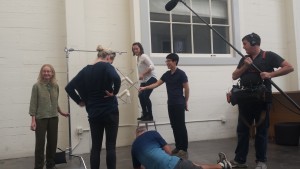Bell Media filmed our tensegrity robot research in October 2015. The feature was aired on Jan. 26, 2016 on the Discovery Channel’s nightly science magazine called the Daily Planet. See video of broadcast. More details on the filming below.
 On October 24, 2015, the tensegrity team of the BEST lab was filmed by Bell Media for the Canadian Discovery Channel. The filming contrasted our sleek and faster Rev3 of the Berkeley Tensegrity Robot with Rev1 featured in their film of 2014 and our previous Rev2. Both Rev1 and Rev2 use elastic cords and linear actuators to shape shift the tensegrity robot into punctuated rolling motion. Rev3 has distributed intelligence with wireless communication between pods on the six rods in compression. Instead of linear actuators, it uses a spooling system with a motor in each pod to increase or decrease the length and thus tension on the wires.
On October 24, 2015, the tensegrity team of the BEST lab was filmed by Bell Media for the Canadian Discovery Channel. The filming contrasted our sleek and faster Rev3 of the Berkeley Tensegrity Robot with Rev1 featured in their film of 2014 and our previous Rev2. Both Rev1 and Rev2 use elastic cords and linear actuators to shape shift the tensegrity robot into punctuated rolling motion. Rev3 has distributed intelligence with wireless communication between pods on the six rods in compression. Instead of linear actuators, it uses a spooling system with a motor in each pod to increase or decrease the length and thus tension on the wires.
The filming focused on three tests for TT-3 (Tim Tensegrity, our name for Rev 3) that had never been done before.
Test 1: The test twin was dropped at heights ranging from 2-5 feet from our drop apparatus. In some of the tests an IMU (inertial measurement unit) was installed on one of the pods to measure acceleration in order to evaluate impact and dynamic properties.
Test 2: TT-3 was tested on soft outdoor terrain. It had only been tested on concrete or the NASA Ames Roverscape before (video below).
Test3: TT-3 was raced against TT-2 (Tracy Tensegrity, our name for Rev 2). TT-2 traveled at 5 cm/sec and handily won the race against Rev2, whose speed was close to that of the Mars Curiosity Rover at less than 1 cm/sec.
See our photo album of TT-3 for more now.
More on our robots at Berkeley Emergent Space Tensegrities.


